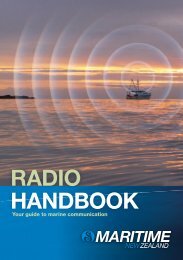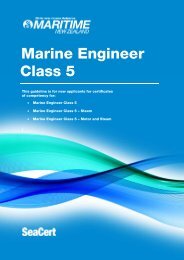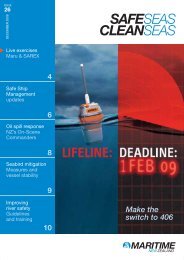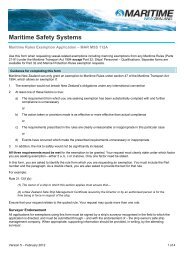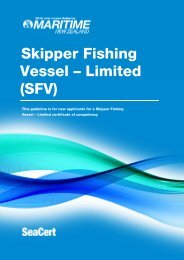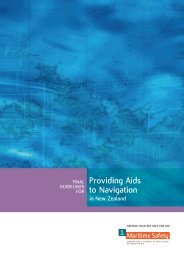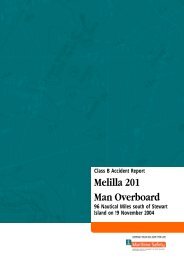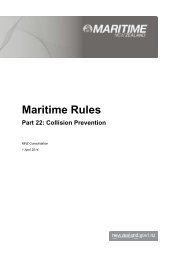Lookout! - Maritime New Zealand
Lookout! - Maritime New Zealand
Lookout! - Maritime New Zealand
You also want an ePaper? Increase the reach of your titles
YUMPU automatically turns print PDFs into web optimized ePapers that Google loves.
Motor launch slams<br />
into moored vessel<br />
A<br />
60 foot motor launch collided with<br />
a moored yacht at night, while the<br />
skipper was preparing to negotiate<br />
a channel.<br />
The impact punched a hole in the launch’s<br />
starboard bow on the waterline, just aft of a<br />
collision bulkhead. The launch immediately<br />
began taking on water and its skipper<br />
attempted to reduce the water ingress by<br />
reversing, but soon lost power to both engines.<br />
The Coastguard attended the scene and<br />
prepared to tow the vessel to safety, but<br />
was forced to cut it free as it continued to<br />
take on water.<br />
The moored yacht was severely damaged and<br />
its rudder pushed sideways. Fortunately, no<br />
one was on board the yacht at the time.<br />
“The impact punched<br />
a hole in the launch’s<br />
starboard bow on the<br />
waterline, just aft of a<br />
collision bulkhead.”<br />
LOOKOUT!POINTS<br />
• Channel navigation requires full<br />
concentration, even from a skipper as<br />
experienced as this one. Although he had<br />
posted a crewmember to keep lookout on<br />
the starboard side of the vessel, the moored<br />
yacht was not seen before the impact.<br />
• The launch was making about 8 knots,<br />
although maritime rules required that it<br />
should not exceed 5 knots. At 8 knots, the<br />
bow of this type of vessel pitches up, limiting<br />
the view from the helm position. There was<br />
also a dinghy lashed to the foredeck, which<br />
may have further limited the skipper’s view.<br />
Skippers should ensure they have an<br />
unobstructed view from the helm position,<br />
and should actively keep a lookout for<br />
potential hazards, particularly when<br />
manoeuvring close to shore. Travelling at<br />
the slowest possible manoeuvring speed<br />
allows more time to react and reduces<br />
damage if an error is made.<br />
The impact left a hole in<br />
the launch’s starboard bow<br />
and the moored yacht was<br />
severely damaged.<br />
Top: Damage to the moored<br />
yacht (left) and launch.<br />
• The skipper was regularly monitoring<br />
the vessel’s GPS and radar. The radar was<br />
set to a range of 1.5 nautical miles. A more<br />
appropriate range would have been 0.5<br />
nautical miles, to give the skipper a better<br />
indication of obstacles and hazards.<br />
• GPS-derived data should only be<br />
used as an aid to navigation, particularly<br />
when operating close to a coastline.<br />
A number of accidents have occurred when<br />
GPS readouts have provided inaccurate<br />
information, resulting in groundings.<br />
MARITIME NEW ZEALAND LOOKOUT! JUNE 2011 17





